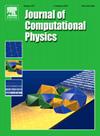Regularity-conforming neural networks (ReCoNNs) for solving partial differential equations
IF 3.8
2区 物理与天体物理
Q2 COMPUTER SCIENCE, INTERDISCIPLINARY APPLICATIONS
引用次数: 0
Abstract
Whilst the Universal Approximation Theorem guarantees the existence of approximations to Sobolev functions –the natural function spaces for PDEs– by Neural Networks (NNs) of sufficient size, low-regularity solutions may lead to poor approximations in practice. For example, classical fully-connected feed-forward NNs fail to approximate continuous functions whose gradient is discontinuous when employing strong formulations like in Physics Informed Neural Networks (PINNs). In this article, we propose the use of regularity-conforming neural networks, where a priori information on the regularity of solutions to PDEs can be employed to construct proper architectures. We illustrate the potential of such architectures via a two-dimensional (2D) transmission problem, where the solution may admit discontinuities in the gradient across interfaces, as well as power-like singularities at certain points. In particular, we formulate the weak transmission problem in a PINNs-like strong formulation with interface and continuity conditions. Such architectures are partially explainable; discontinuities are explicitly described, allowing the introduction of novel terms into the loss function. We demonstrate via several model problems in one and two dimensions the advantages of using regularity-conforming architectures in contrast to classical architectures. The ideas presented in this article easily extend to problems in higher dimensions.
求助全文
约1分钟内获得全文
求助全文
来源期刊

Journal of Computational Physics
物理-计算机:跨学科应用
CiteScore
7.60
自引率
14.60%
发文量
763
审稿时长
5.8 months
期刊介绍:
Journal of Computational Physics thoroughly treats the computational aspects of physical problems, presenting techniques for the numerical solution of mathematical equations arising in all areas of physics. The journal seeks to emphasize methods that cross disciplinary boundaries.
The Journal of Computational Physics also publishes short notes of 4 pages or less (including figures, tables, and references but excluding title pages). Letters to the Editor commenting on articles already published in this Journal will also be considered. Neither notes nor letters should have an abstract.
 求助内容:
求助内容: 应助结果提醒方式:
应助结果提醒方式:


